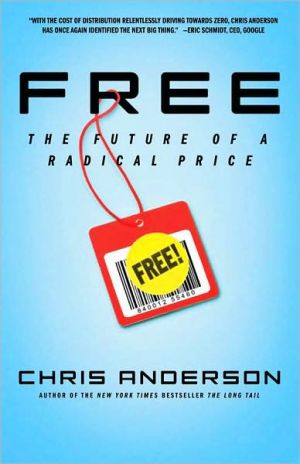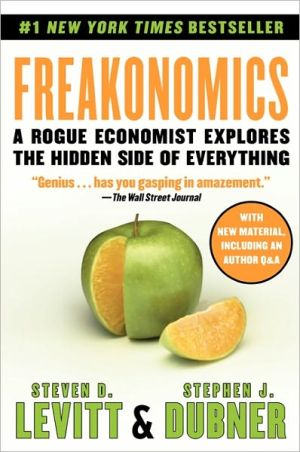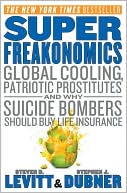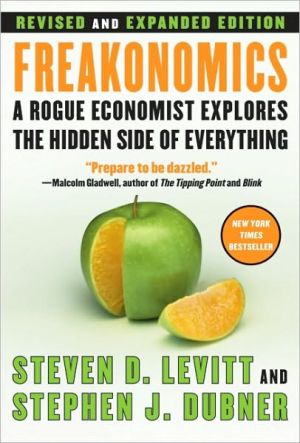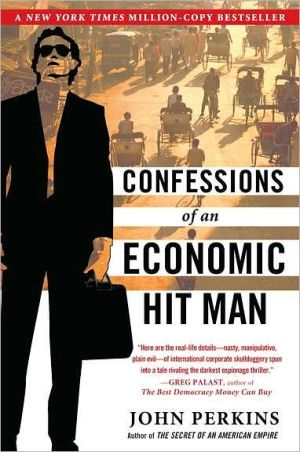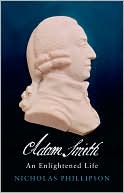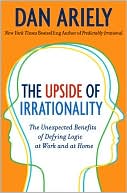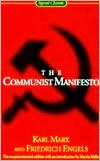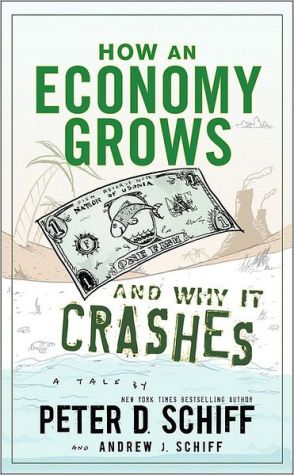Free: The Future of a Radical Price
The New York Times bestselling author heralds the future of business in Free.\ In his revolutionary bestseller, The Long Tail, Chris Anderson demonstrated how the online marketplace creates niche markets, allowing products and consumers to connect in a way that has never been possible before. Now, in Free, he makes the compelling case that in many instances businesses can profit more from giving things away than they can by charging for them. Far more than a promotional gimmick, Free is a...
Search in google:
The New York Times bestselling author heralds the new future of business in Free. In his revolutionary bestseller, The Long Tail, Chris Anderson demonstrated how the online marketplace creates thriving niche markets, allowing products and eager consumers to connect in a way that has never been possible before. Now, in Free, he makes the compelling case that in many instances businesses can profit more from giving things away than they can by charging for them. In order to succeed in the twenty-first century economy, Free is more than a promotional gimmick: It's a business strategy that is essential to a company's successful future.Traditional economics operates under fundamental assumptions of scarcity. After all, there's only so much oil, iron, and gold in the world. But what if the fundamentals of an economy aren't governed by constraints? The growing online economy is built upon three cornerstones: processing power, hard drive storage, and bandwidth. The costs of all these elements are trending toward zero at an incredible rate. Just think that in 1961, a single transistor cost $10, and now Intel's latest chip has two billion transistors and sells for $300 (or 0.000015 cents per transistor-effectively too cheap to price). Never in the course of human history have the primary inputs to an industrial economy fallen in price so fast and for so long. This is the engine behind the new Free, the one that goes beyond a marketing gimmick or a cross-subsidy. In a world where prices always seem to go up, the cost of anything built on these three technologies will always go down. And keep going down, until they are as close to zero as possible. In Free,Chris Anderson explores this radical idea for the new economy, and demonstrates how this revolutionary price can be harnessed for the benefit of both consumers and business alike. The Barnes & Noble Review "The Future of a Radical Price," says the subtitle of Chris Anderson's Free. But for many readers unschooled in the preposterous paradoxes of the Internet economy, the idea of "free" as a financial price sounds ridiculous rather than radical, more comic than economic, closer to Monty Python's Flying Circus than to Adam Smith. Perhaps it is no coincidence, then, that Anderson begins Free with the hilariously stern public announcement made by the Monty Python team on the free video website YouTube in November last year. This note began in classically Monty Python tongue-in-cheek outrage: For 3 years you YouTubers have been ripping us off, taking tens of thousands of our videos and putting them on YouTube. Now the tables are turned. It's time for us to take matters into our own hands. The logical response, of course, would have been for Monty Python to hire some killer lawyers and sue the pants off the kleptomaniac kids. But, as Anderson explains, "taking matters into our own hands" meant quite the reverse for the Monty Python team. Instead of building more secure walls around their content, Monty Python would post all their high-quality videos on YouTube. And it would all be free!
\ Rob PegoraroAnderson…provides useful insights into both the market forces he describes and what to do about them. \ —The Washington Post\ \ \ \ \ Janet MaslinMr. Anderson has come up with a lively conversation piece. Even when the particulars of his argument are easily assailable, the gist is clear: Now that a cornucopia of Internet material has been made available without fee, and in some cases without scruples, the smart business must find ways to adapt to that new reality. "The way to compete with Free is to move past the abundance to find the adjacent scarcity," he writes. And Free is full of specific examples of how to do just that.\ —The New York Times\ \ \ Publishers WeeklyIn the digital marketplace, the most effective price is no price at all, argues Anderson (The Long Tail). He illustrates how savvy businesses are raking it in with indirect routes from product to revenue with such models as cross-subsidies (giving away a DVR to sell cable service) and freemiums (offering Flickr for free while selling the superior FlickrPro to serious users). New media models have allowed successes like Obama's campaign "billboards" on Xbox Live, Webkinz dolls and Radiohead's name-your-own-price experiment with its latest album. A generational and global shift is at play-those below 30 won't pay for information, knowing it will be available somewhere for free, and in China, piracy accounts for about 95% of music consumption-to the delight of artists and labels, who profit off free publicity through concerts and merchandising. Anderson provides a thorough overview of the history of pricing and commerce, the "mental transaction costs" that differentiate zero and any other price into two entirely different markets, the psychology of digital piracy and the open-source war between Microsoft and Linux. As in Anderson's previous book, the thought-provoking material is matched by a delivery that is nothing short of scintillating. (July)\ Copyright © Reed Business Information, a division of Reed Elsevier Inc. All rights reserved.\ \ \ \ \ Library JournalWhile the best things in life may be free, a business model based on giving stuff away seems a little crazy. But Anderson (editor in chief, Wired), who made a big splash with The Long Tail, tells us that this business model is already here. In The Long Tail, he showed how online businesses were making good by selling less of more, that is, by selling a huge range of niche or low-volume products that added up to big bucks. Here he demonstrates that the concept of making money by giving things away has already taken hold in the digital world. VERDICT With explanations of basic economic principles like supply and demand and an analysis of the differences between products in the physical world and those in the digital world, Anderson makes the Free premise sound quite reasonable. Lots of companies are making lots of money from "free." Google and Yahoo, for instance, have some of the biggest computer server complexes in the world, yet they let us use their email, news, and search services every day. While this book may not be free, it will generate interest among both academic and general readers.—Carol J. Elsen, Univ. of Wisconsin, Whitewater\ \ —Carol J. Elsen\ \ \ \ \ The Barnes & Noble ReviewThe Future of a Radical Price, says the subtitle of Chris Anderson's Free. But for many readers unschooled in the preposterous paradoxes of the Internet economy, the idea of "free" as a financial price sounds ridiculous rather than radical, more comic than economic, closer to Monty Python's Flying Circus than to Adam Smith. Perhaps it is no coincidence, then, that Anderson begins Free with the hilariously stern public announcement made by the Monty Python team on the free video website YouTube in November last year. This note began in classically Monty Python tongue-in-cheek outrage: \ For 3 years you YouTubers have been ripping us off, taking tens of thousands of our videos and putting them on YouTube. Now the tables are turned. It's time for us to take matters into our own hands.\ The logical response, of course, would have been for Monty Python to hire some killer lawyers and sue the pants off the kleptomaniac kids. But, as Anderson explains, "taking matters into our own hands" meant quite the reverse for the Monty Python team. Instead of building more secure walls around their content, Monty Python would post all their high-quality videos on YouTube. And it would all be free!\ So where's the rational economics in this? any reasonable thinking person would wonder. How can Monty Python make money if they give away their content for free? Herein lies the paradox of today's digital economy. As the announcement explained, Monty Python wanted something "in return" for their free content. But rather than their fans' "driveling, mindless comments," Monty Python wanted them to watch the free content on YouTube and then "click on the links, buy our movies and TV shows and soften our pain."\ As Anderson triumphantly reports in Free, YouTube viewers did indeed soften Monty Python's pain. Three months after the YouTube "free" experiment, Monty Python's sales at Amazon.com increased by 23,000 percent and their DVD rocketed up to No. 2 on the movie and TV bestseller list.\ It could have been a classic Monty Python skit, but it wasn't. Give away all your best content on the Internet and raise real sales by 23,000 percent! Not even John Cleese could have written anything that unbelievably absurd.\ While Anderson -- the author of the 2006 bestseller The Long Tail who moonlights as the editor-in-chief of the Condé Nast–owned, San Francisco–based Wired magazine -- might not be quite as funny as Cleese, his Free is an accessible and highly entertaining riff on the conundrums of today's digital economy. According to Anderson, "Freeconomics" is enabled by digital technology, which "nearly" halves the cost of computer processors, Internet bandwidth, and online storage, thereby cramming down the price of distributing online content closer and closer to zero.\ This zero cost of distributing digital content is, Anderson argues in Free, the core principle of the 21st-century "radical" economy. The 20th-century industrial market of "atoms" is replaced by the informational market of "bits." Digital information -- such as Monty Python videos on YouTube -- is infinitely abundant and, therefore, will inevitably be free. But Anderson, an Anglo-American economics journalist who earned his spurs in the dismal science at the dismally realistic Economist magazine, is no misty-eyed, end-of-history style cornucopian. He acknowledges that this digital abundancy creates valuable new scarcities in the 21st century, primarily those of attention and reputation, the two gold standards of the digital age.\ The most radical implication of Anderson's theory is the commodification of all-things-digital and the revaluation of all-things-physical in the 21st century. Thus, using his own creative self as an example of his theory, Anderson explains that while he's perfectly happy to give away copies of Free online because it costs him nothing to store or distribute, the increasing scarcity of his time drives up the price of his live speeches, thereby enabling him, he confesses, to save enough money to send all five of his kids to college.\ Anderson is, of course, correct. The Internet is killing the value of most digital content while simultaneously driving up the value both of high-end physical products and of live performance. He thus also uses the example of Radiohead's In Rainbows album, which the band gave away for free online but which ended up selling 3 million copies worldwide, including 1 million copies of a deluxe $80 box set, and triggered the sale of 1.2 million tickets for their post-album tour.\ While all this macro-historical economic theory might sound a tad technical for general readers, Anderson writes about the digital transformation with verve and humor. I particularly enjoyed his all-too-brief history of the economic theory of free, with the priceless anecdote about the late-19th-century French mathematician, Joseph Bertrand, who "half-joking" reworked another French mathematician's model of free economics -- only to find that this "marginal cost pricing" theory turned out to be correct!\ For humor, though, the best joke in Free concerns, in classic Monty Python fashion, dirty toilets. In discussing the environmental costs of 21st-century free economy, which Anderson acknowledges to be myriad, he dryly describes the olfactory consequences of free public toilets as "uncompensated negative externalities." Certainly this gives new meaning to Anderson's eighth principle of abundance thinking, entitled: "Embrace Waste."\ Free won't be humorous for all readers. What will be entertaining reading for entrepreneurs at freeconomy companies like Google, will be consumed in gray, humorless silence by professionals of the old atoms economy. For these denizens of the old economy, reading Free will be as unpleasant as visiting a free public toilet. Indeed, Anderson gives explicit warning to travel agents, stockbrokers, and realtors to discover new scarcity in the age of digital abundance. But, of course, the sharpest polemic in Free is directed toward old-media dinosaurs whose refusal to radically rebuild their businesses is now decimating the music, newspaper, and book industries.\ So is Anderson right? One profoundly important subject that only gets a cursory chapter in Free is the destructive costs of the new digital economy. My advice is to read Free in parallel with Ellen Ruppel Shell's essential new book about the downside of free: Cheap: The High Cost of Discount Culture. "Cheap" and "Free" are the two key words in our current thinking about the global economy and culture, and both these valuable books will help shape an important debate about the pricing, value, and quality of life in the 21st century.\ The least convincing area in Free concerns Anderson's faith in the business models of Silicon Valley's radical-price (and radically priced) companies. Just because the old atom economy of newspapers and record labels is dying, it doesn't inevitably mean that the new digital freeconomy is viable. And while Anderson is on firm ground covering Google's phenomenal success as the increasingly monopolistic locomotive of the new economy, he's less convincing describing the supposed viability of highly trafficked free web "businesses" like Second Life, MySpace, YouTube, and Twitter -- none of which have yet to discover a profitable business model.\ I wonder if Chris Anderson watched a bit too much Monty Python in researching Free. In his treatment of contemporary Silicon Valley economics, he might be seen as impersonating John Cleese in that timeless apotheosis of Monty Python's surrealism: the dead parrot sketch. By continually waving the business models of dead or dying companies like MySpace and Second Life at us, Anderson is vulnerable to becoming the victim of his own joke.\ And for those of you not familiar with the dead parrot sketch, you can check it out on the Monty Python channel of YouTube. Not only is it is ludicrously funny, but it's also free (like this review). Then I would advise you to stay online and order a physical copy of Chris Anderson's Free. It might not be quite as radically absurd as the dead parrot sketch, but it is currently the spunkiest introduction to the most preposterous paradoxes of the 21st-century digital economy. --Andrew Keen\ Andrew Keen is author of the 2007 international hit The Cult of the Amateur, which has been translated into 15 foreign languages. He writes a weekly column about culture, technology and media for the London Daily Telegraph and regularly tweets at www.twitter.com/ajkeen.\ \ \
